Swansea City progressed through to the FA Cup quarter-final for the second successive season, recovering from a 1-0 half time deficit to beat Brentford 4-1 in emphatic fashion at the Liberty Stadium. In this FA Cup tactical analysis, we’ll take an in-depth look at the key battles between the two sides and how Swansea City recovered from a poor first-half display to running out as worthy winners after a thrilling second 45 minutes.
There looked like there was only going to be one winner at half-time. Brentford were in complete control and they should have got themselves into a more comfortable lead at the break having got into some excellent attacking positions. However, only two of their 10 first-half shots hit the target and that proved to be their downfall. Swansea, on the other hand, only managed one shot themselves but were clinical after the break.
Lineups
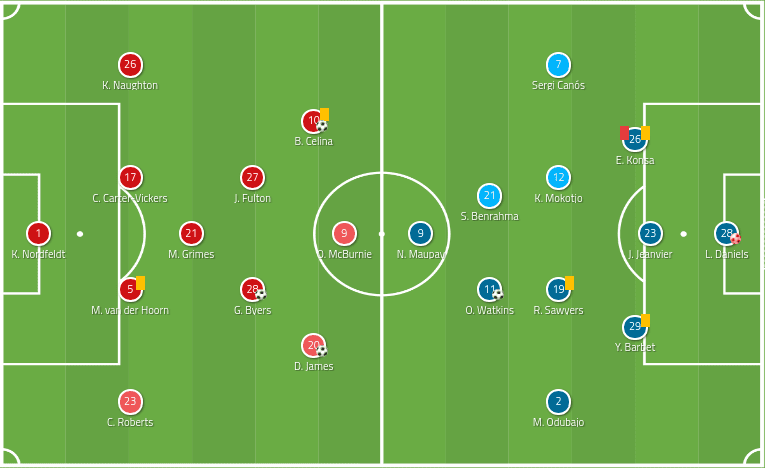
Swansea City manager Graham Potter made just two changes from the side that lost 2-1 at Leeds United in the EFL Championship on Wednesday night. Oli McBurnie recovered from illness to start to replace Barrie McKay and the other change saw Erwin Mulder make way for Kristoffer Nordfeldt between the sticks.
Brentford adopted a back three, making effective use of their front three as a useful pressing unit, while wing-back Odubajo especially saw plenty of action down the left flank in the first half.
Brentford pressing frustrates Swansea
Swansea’s performance in the first 45 minutes was lethargic and slow. In fairness, this was partly down to Brentford’s commitment to a high press, with five or sometimes six players inside Swansea’s half out of possession.
Within the first two minutes, they forced the home side into a mistake with a poor pass out to right-back Connor Roberts. Brentford were able to win the ball back in Swansea’s defensive third, with players well positioned in and around the penalty area to create quick goalscoring opportunities.
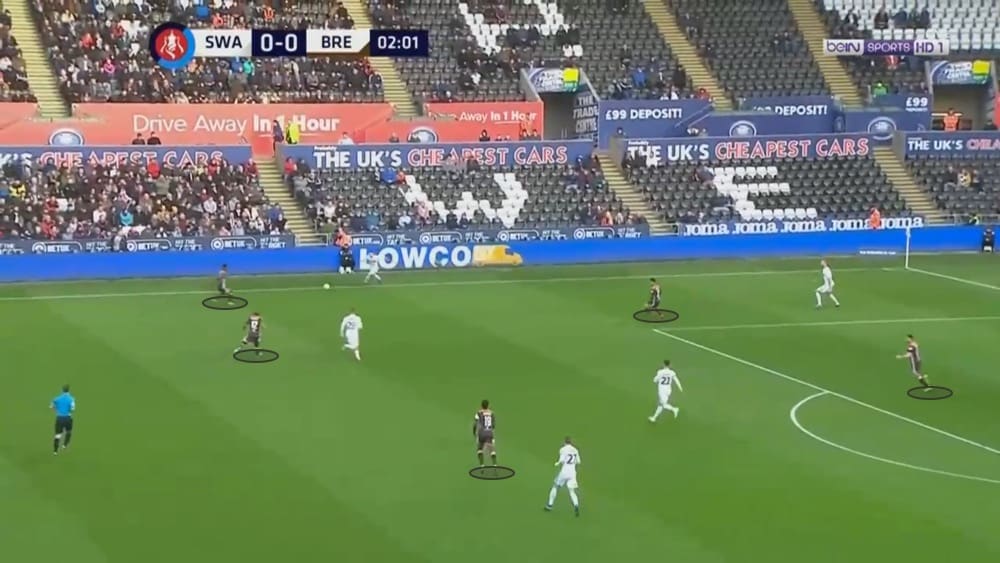
Brentford’s press was well executed. Players were well-positioned to block key passing lanes as Swansea City tried and failed to play their usual game out from the back.
In previous games this season, we’ve seen Swansea play out from the back with an effective back three and a second midfielder to form a diamond. Matt Grimes has either dropped in between or to the left of the two centre-backs to form a back three as they look to move the ball out from the backline.
Brentford, however, put a complete stop to that as you can see in the image below. The full-backs are normally committed forward near the half-way line during the first phase of possession, but they had to drop back in support against Brentford’s five-man press.
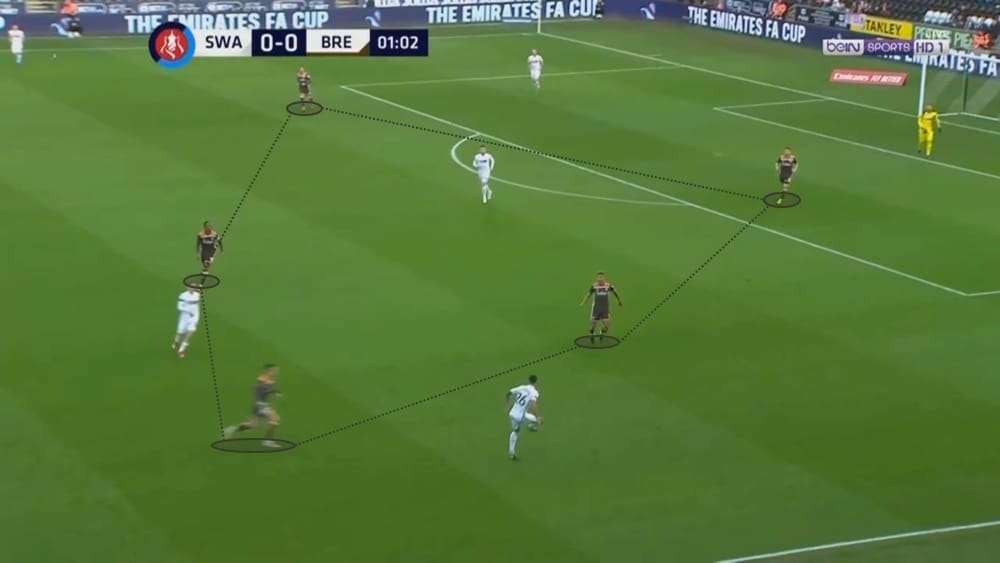
Matt Grimes has been key to Swansea’s deep build-up play but Brentford identified him as a player that they needed to press and block passes to. The image below shows Grimes in possession being pressed. There are another five Brentford players equally positioned around the midfielder who can block all of his closest passing options.

You can see Swansea’s back three below, with Grimes dropping in between the two centre-backs, but it can’t be used due to Brentford’s high press. Full-back Kyle Naughton has to drop deeper than he would like to in order to offer a passing option but his passing lane inside to midfielder George Byers is blocked off. Therefore, Swansea have to go backwards again.
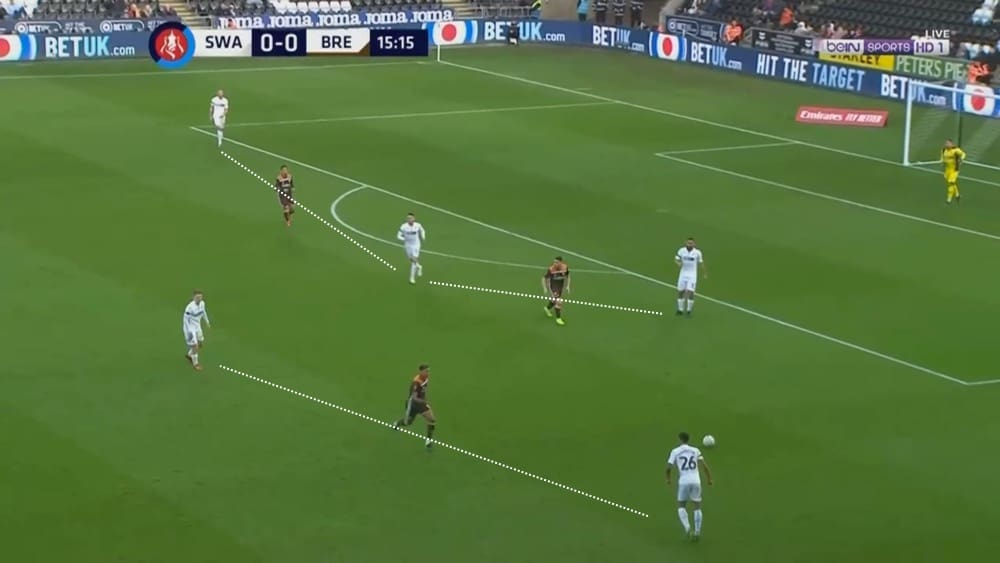
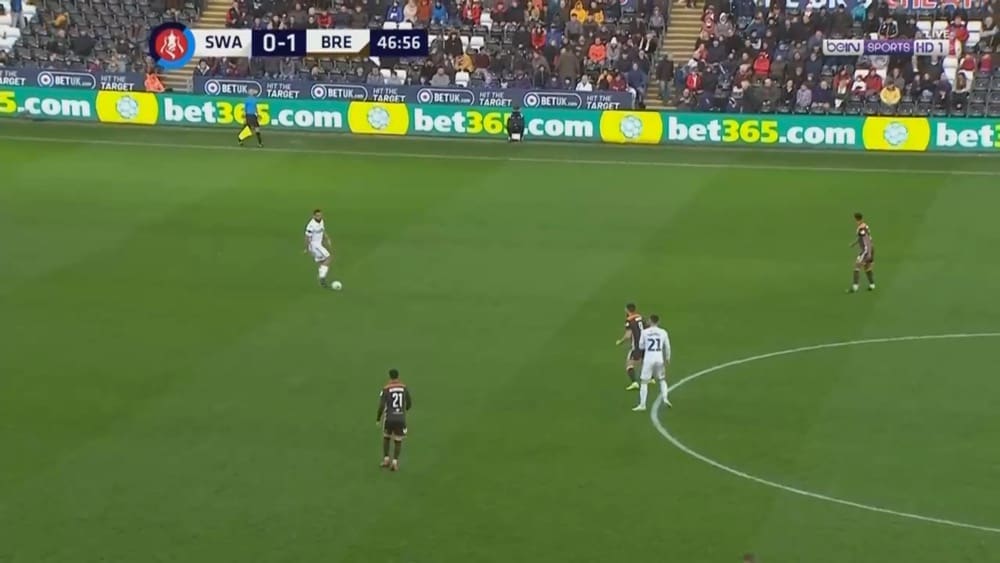
Swansea’s counter-attack vulnerability
Earlier we pointed out how Swansea City’s full-backs were forced to drop deeper to support the defenders and Grimes in possession against Brentford’s five or six-man press. When the hosts did manage to get the ball further forward, the full-backs could then push forward in their usual manner.
Down the right side, where Dan James was also looking to get in behind at every opportunity, Swansea had a vulnerability against the counter-attack as they left a huge area of open space if they lost possession. Brentford could then easily move the ball forward to a player in space. Their left wing-back had the green light to bomb forward and the visiting side were in behind, leaving the Swans rushing back.
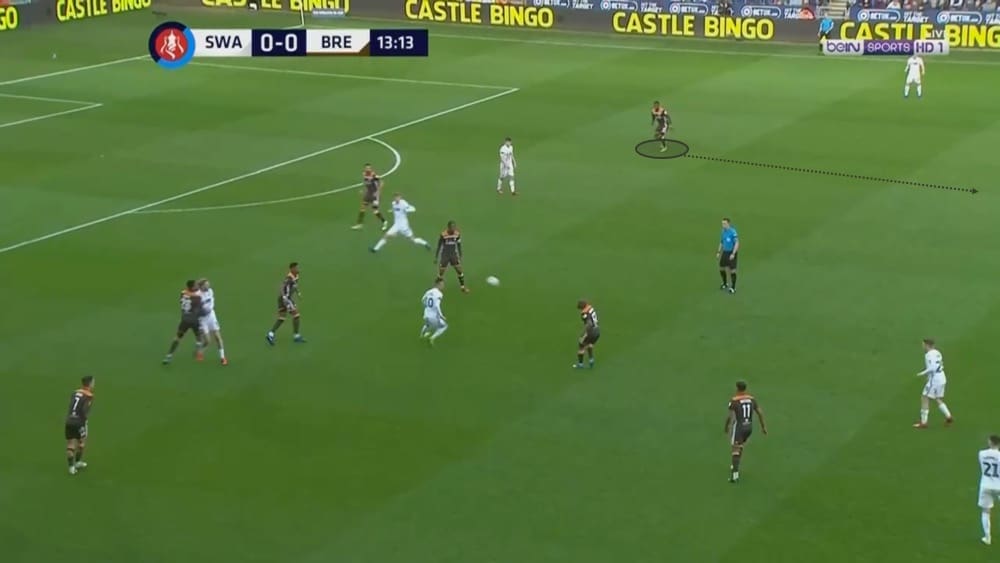
The image above shows Swansea losing possession on the edge of the final third and Brentford regaining the ball in midfield. This gives their left wing-back the trigger to move forward. Swansea’s right-back Connor Roberts is out near the right touchline at the top right of the image. Dan James has moved inside so they have no cover against the counter.
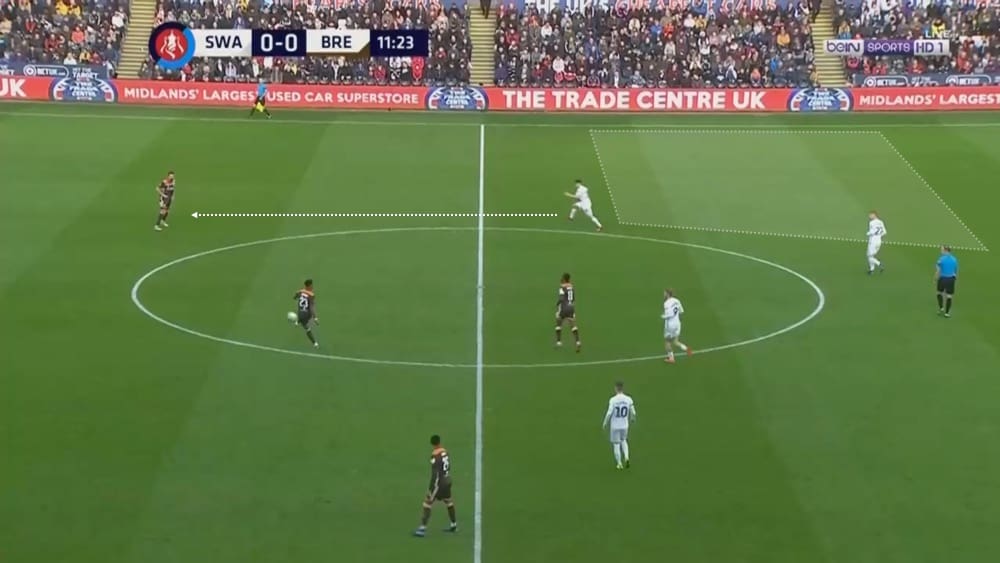
Below is another example six minutes later, but this one shows Brentford as they move the ball into the final third. Connor Roberts is back in position but Dan James is far too advanced up the pitch to offer defensive cover, leaving a huge open space down that flank.
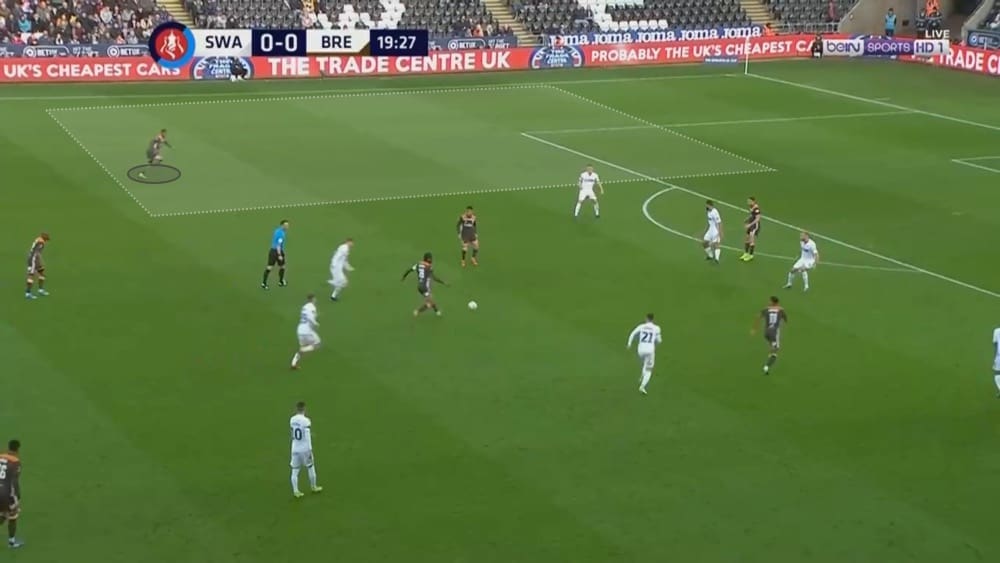
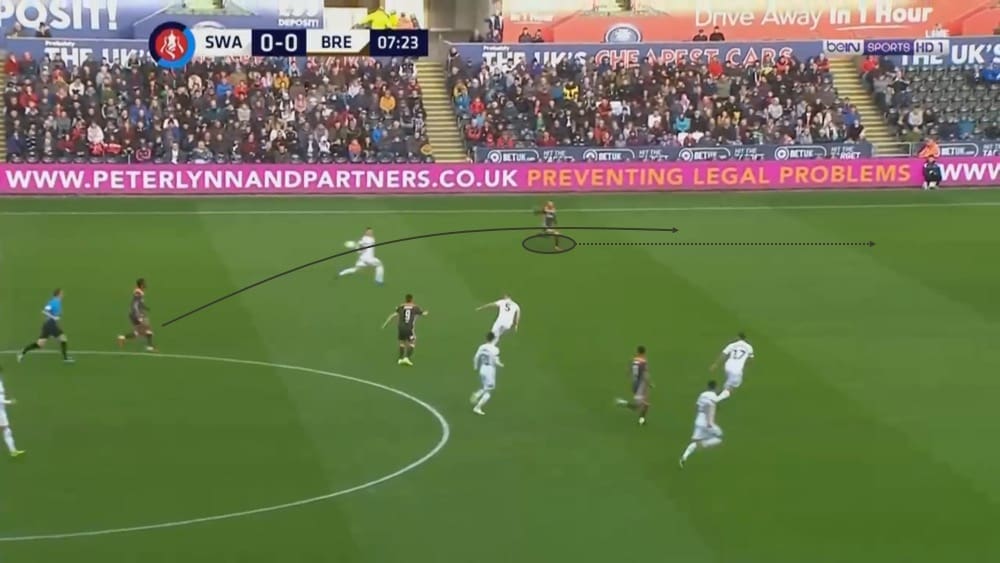
Potter’s attempts to fix his side’s problems
Graham Potter has proved to be a versatile and proactive tactician who is quick to react and make changes as required. His side were struggling against Brentford, to say the least. They lacked any tempo in their passing game.
Brentford completely nullified them in wide areas, particularly down the right where Dan James was playing initially. Striker Oli McBurnie, who hit a double in the previous round against Gillingham, struggled to get involved. To do so, he often dropped very deep into his own half to help link up the play down the right flank.
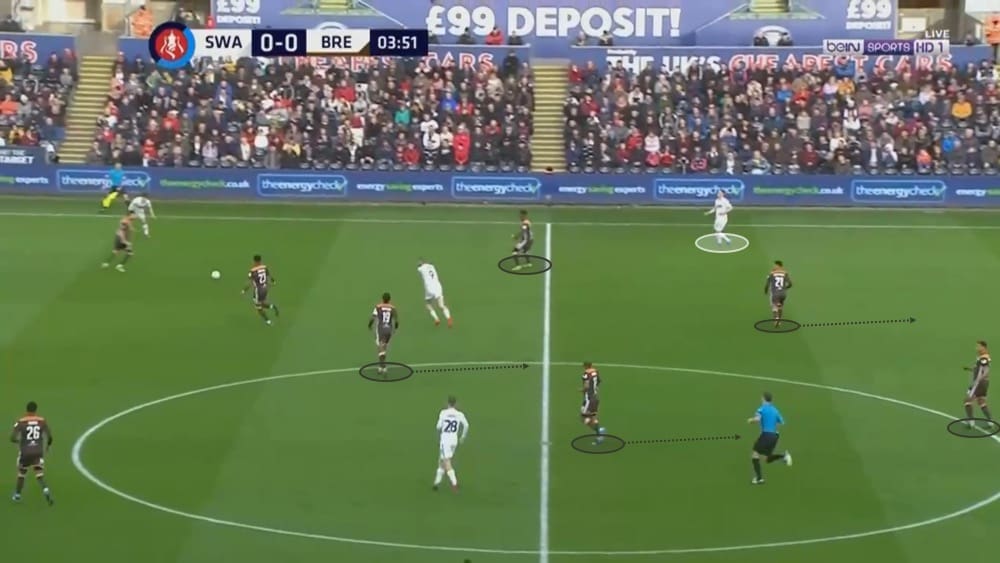
Potter shuffled his front three during the first half. McBurnie started off playing through the middle with Dan James on the right and Bersant Celina on the left. His first change saw Oli McBurnie moving to the left side, swapping with Celina who later played through the middle (below).
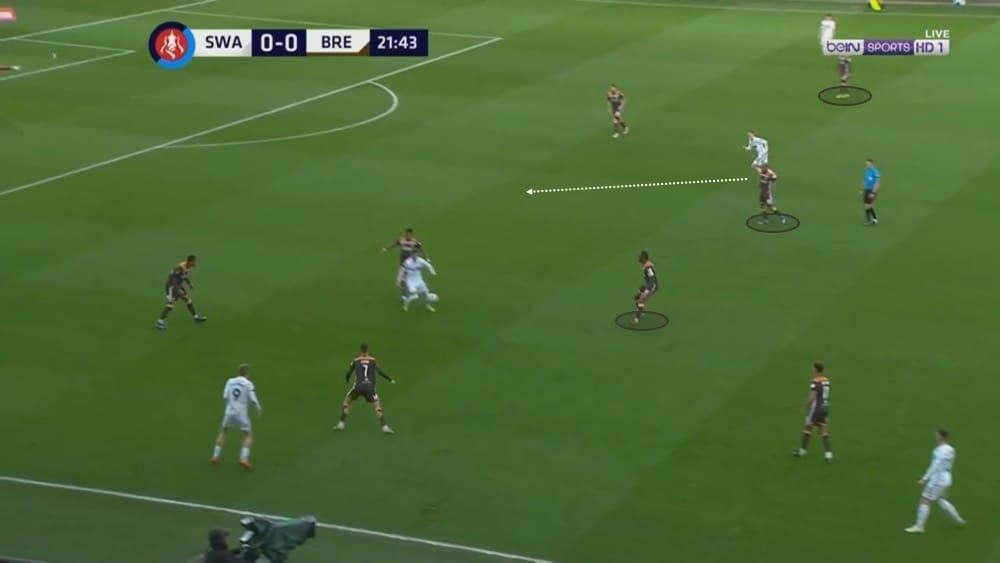
Later, McBurnie moves over to the right with Dan James now switching flanks. Knowing McBurnie likes to drop deep anyway to involve himself in the game, Potter would hope that this would offer greater security down that side against the counter.
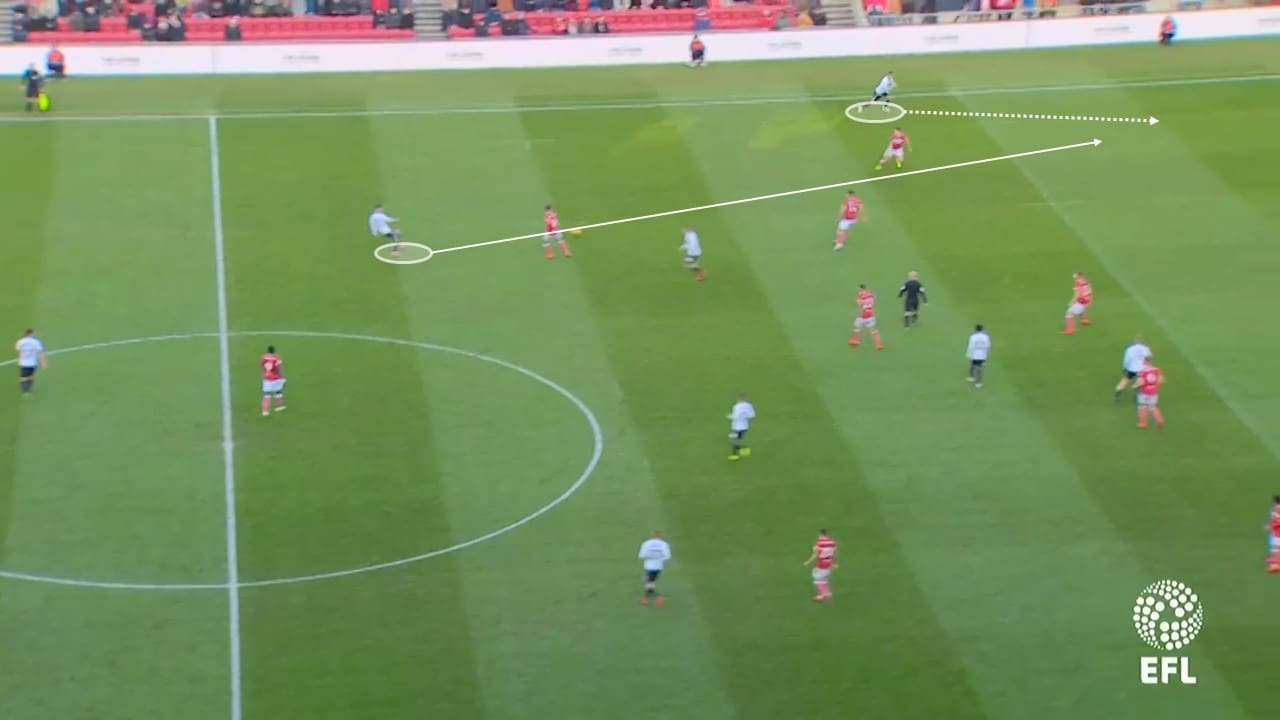
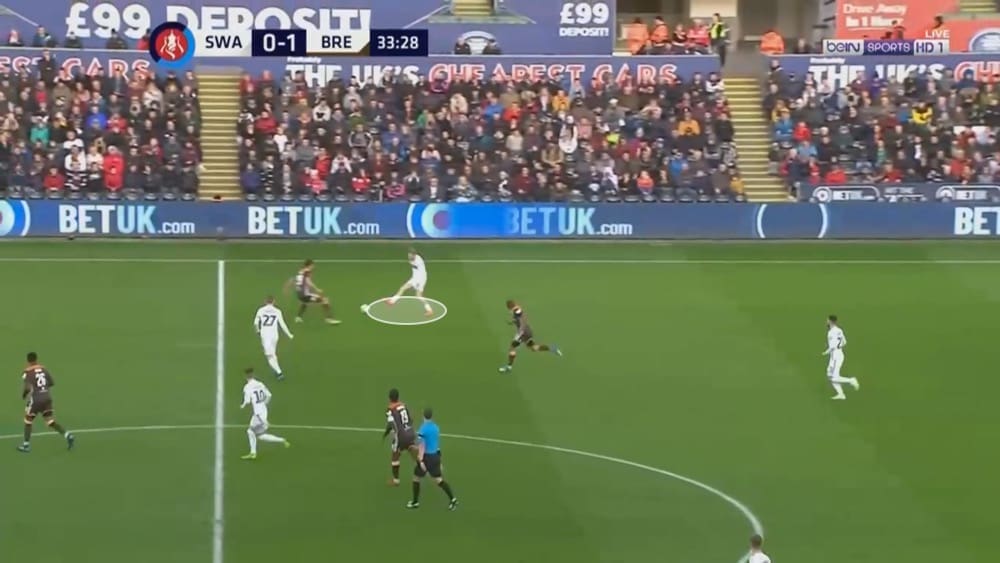
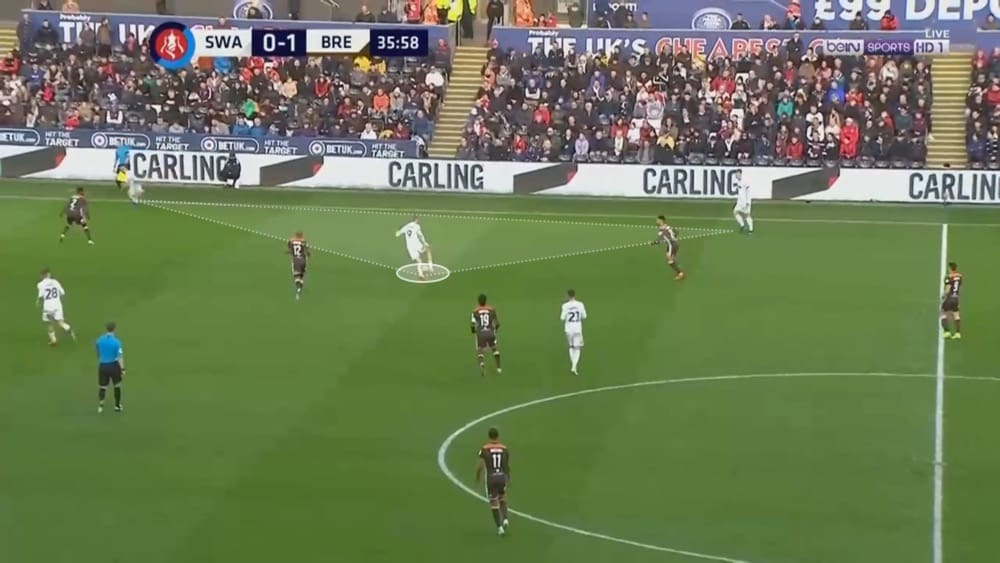
Brentford take a deserved lead
Brentford took a deserved lead after 28 minutes with an excellent, quick counter-attacking move as they took full advantage of Swansea’s sloppy play in the final third. The first mistake sees a sloppy sideways pass from George Byers that’s aimed behind Connor Roberts. This forces defender Mike van der Hoorn forward and out from his covering defensive position, shown below. He recovers the ball and helps it on to Roberts.
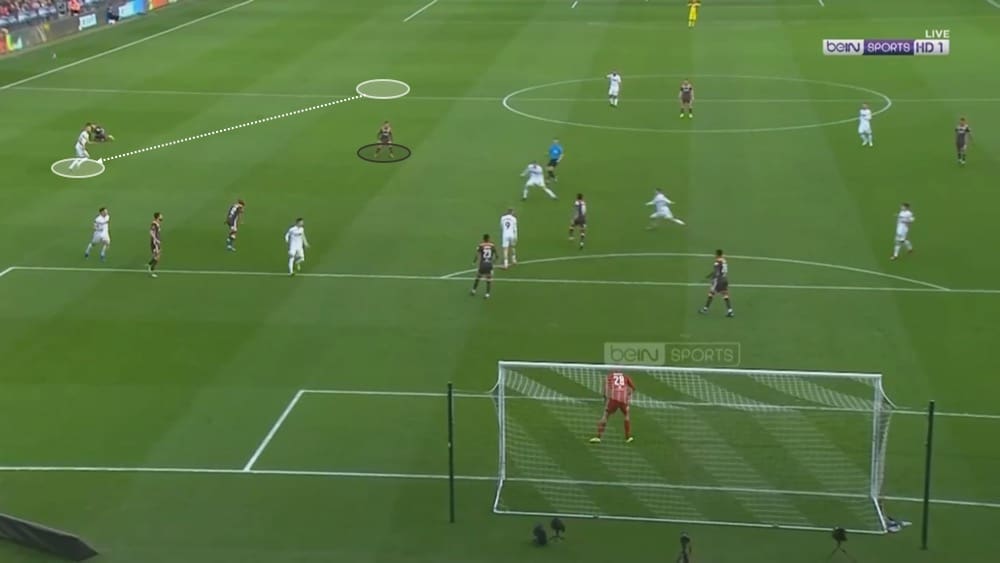
The second mistake sees Connor Roberts and Bersant Celina on different wavelengths. Celina makes a run through the inside channel but Roberts cuts a pass back to him inside which Brentford intercept. Within two or three passes they’re on the attack, three versus two, as Maupay slips the ball to his right for Watkins to finish past Nordfeldt.
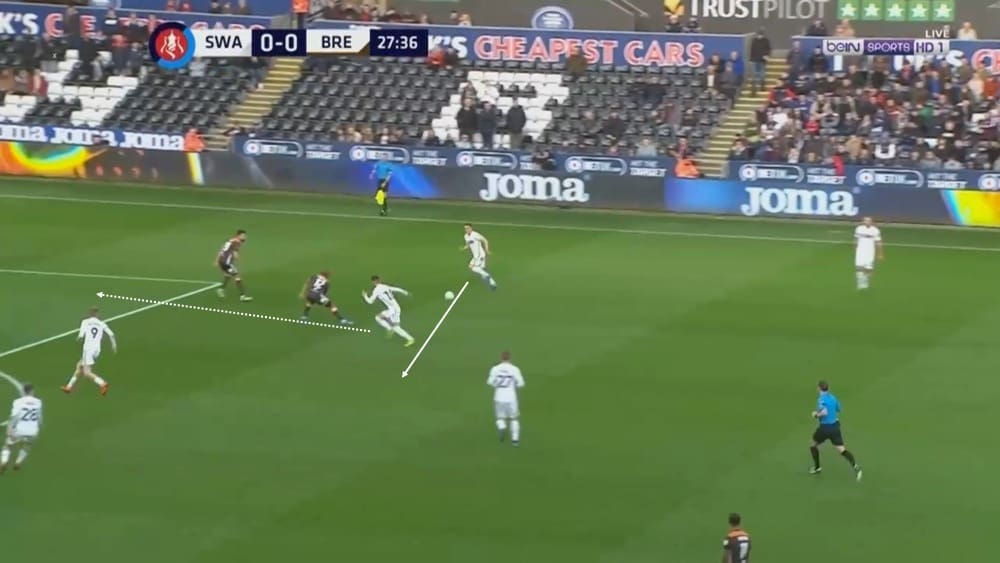
It was a lead and an opening goal from the Bees that had been coming and one that they deserved. Swansea, in fact, were fortunate that they were only a goal behind going into the break. The hosts were in desperate need to get into the dressing room and regroup.
Swansea’s second-half response
After some last-ditch defending early in the second half as Brentford went close to netting a second goal and doubling their lead, Swansea City got themselves into a promising free-kick position following a foul on star man Dan James.
Bersant Celina’s effort curled over a wall that refused to jump, hit the post and went in off the goalkeeper. An own goal, and Swansea were level after barely having a sniff in front of goal in the previous 48 minutes of the match.
Dan James
A special section of this tactical match analysis has to go to Swansea City’s star man and winger Daniel James. You can see why Leeds United and Marcelo Bielsa were so keen to bring him to Elland Road on transfer deadline day. The move failed at the final hour, and a couple of weeks later he’s had a huge role in seeing his side into the FA Cup quarter-finals.
Four minutes after Celina forces an own goal equaliser from his direct free-kick, a free-kick won by Dan James, James himself steals the show. Brentford play the shortest of free-kicks, simply knocking the ball into the path of a player who looks to dribble inside towards the box.
As the Brentford runner moves towards the middle of the pitch, Dan James races off his defensive line, blocks a pass and then proceeds to attempt to beat Bolt’s 100m record. He knocks the ball on to chase, knowing he’ll outrun anyone, and nine seconds later he’s in on goal. He still finds the composure the slot the ball past the goalkeeper to put his side into the lead.
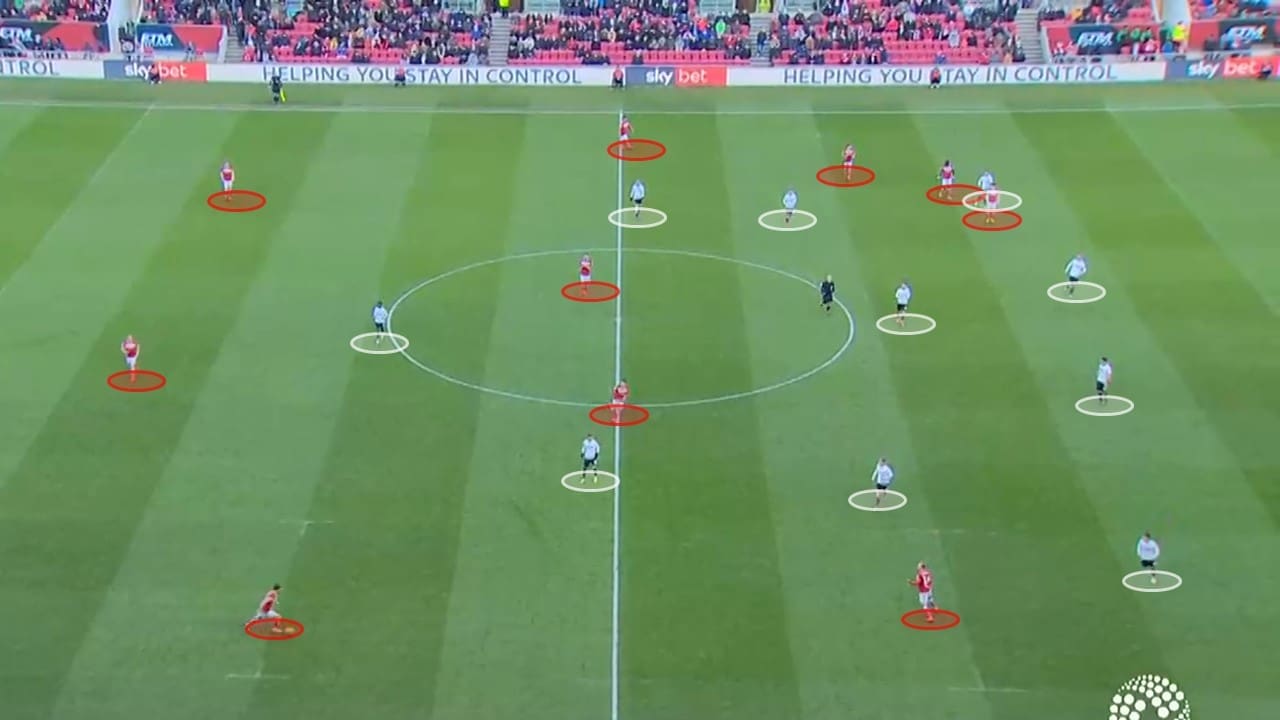
An excellent free-kick that was helped with a bit of luck, then individual skill and incredible pace had got the hosts in front. But together with that, there was a different level of desire and energy on show after a tepid first 45 minutes.
By this point, Dan James was proving to be too much to handle. He had struggled in the first half, such was Brentford’s excellent shape and high pressing, but there was a change in dynamic in the second half.
With more space now opening up, James was able to knock the ball on again for him to chase through the middle. With no other covering defenders, we can see below how Ngoyo attempts a challenge but he brings the 21-year-old down. There was no hesitation from the referee in showing the red card.
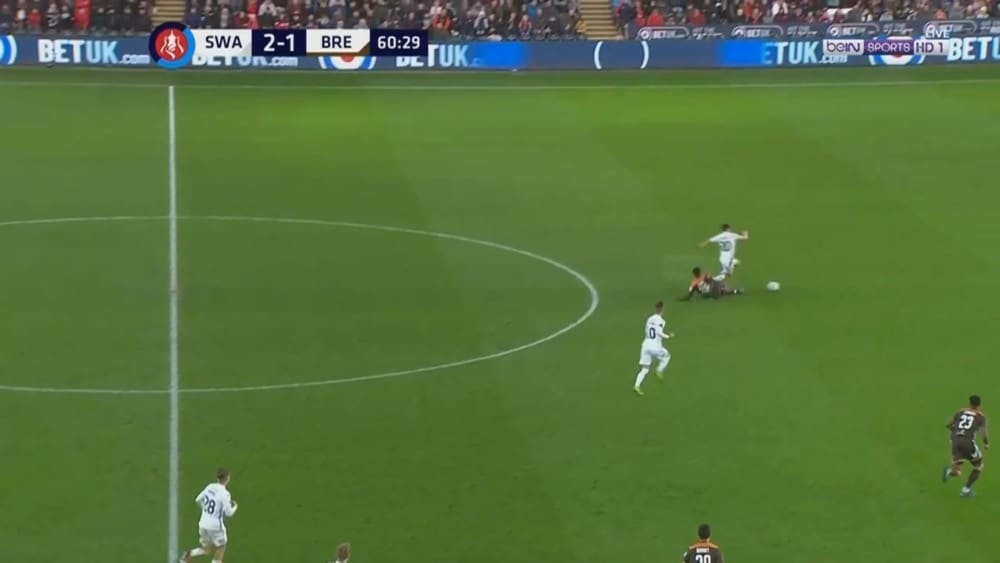
Brentford still had a chance to get back into the game at 2-1 but the red card opened up the game even more and Swansea City made full use of the space. After having to score an injury-time equaliser to salvage an EFL Championship point at home against Birmingham City, Swansea City didn’t make the same mistake twice against 10 men as they went looking to guarantee their place in the quarter-finals.
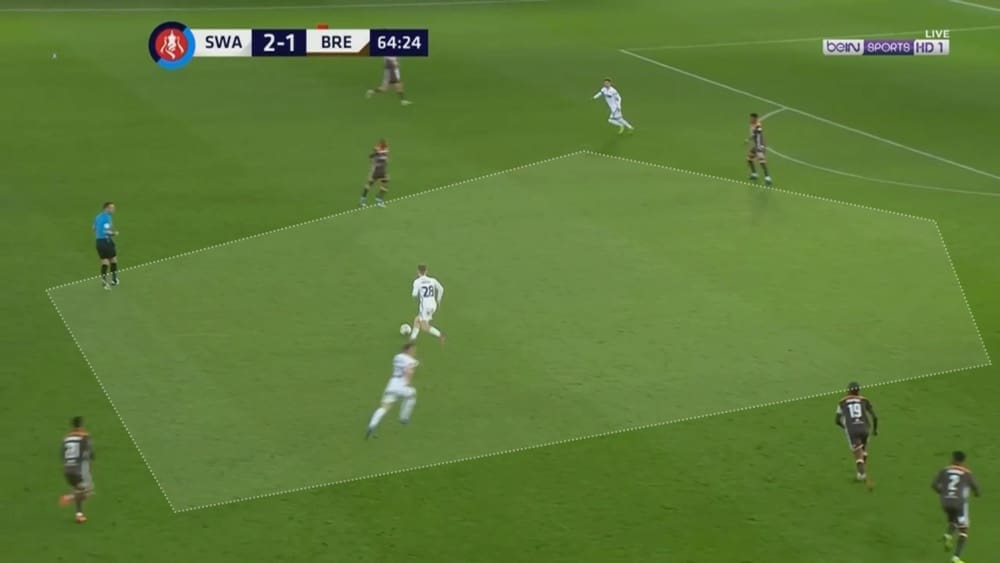
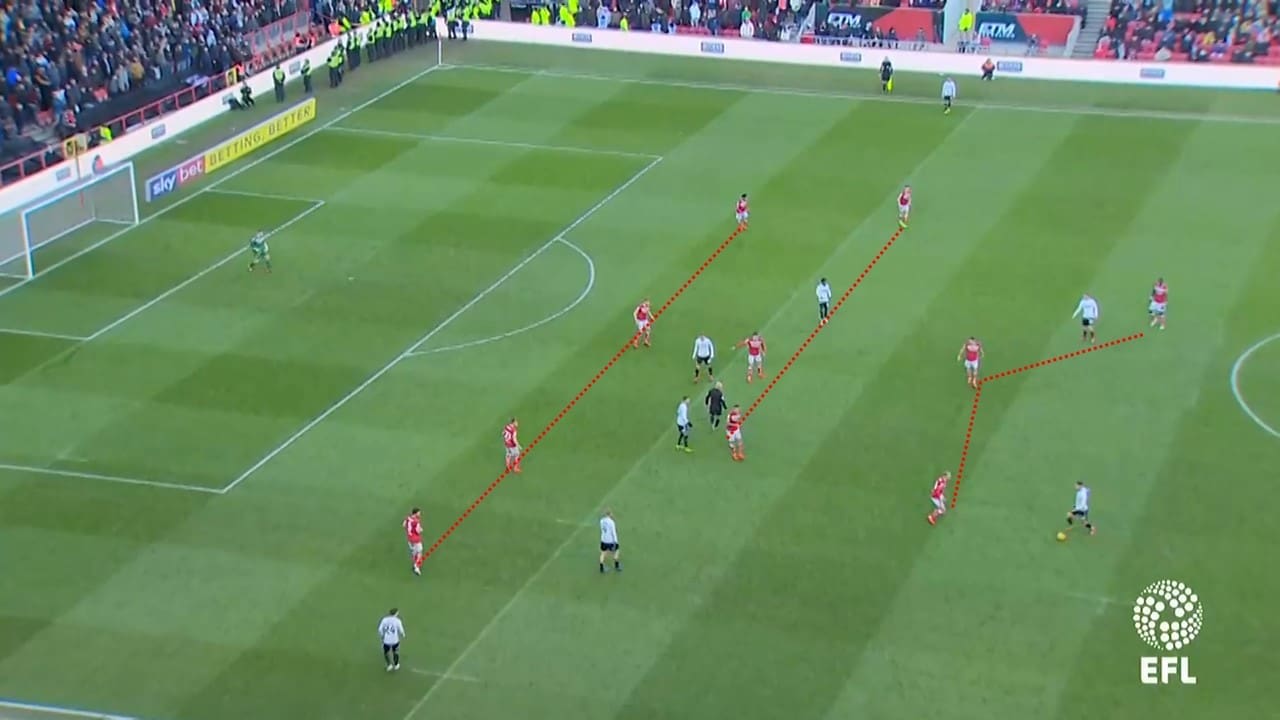
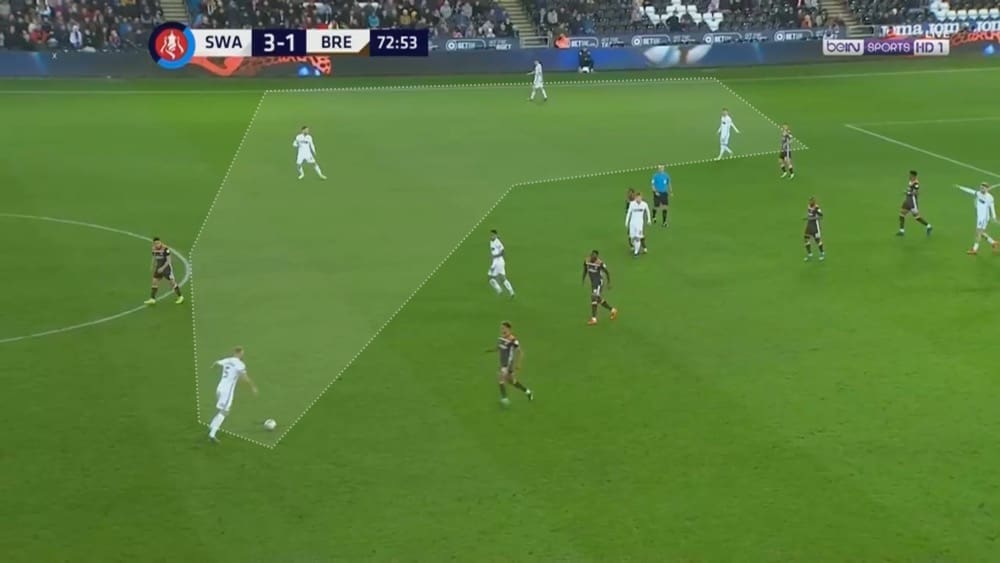
Swansea City found it frustrating and difficult to play out from the back in the first half against Brentford’s effective high press. After the sending off, however, the visitors had to drop deeper as they switched to a back four and with one less midfielder, this left gaps in wide areas.
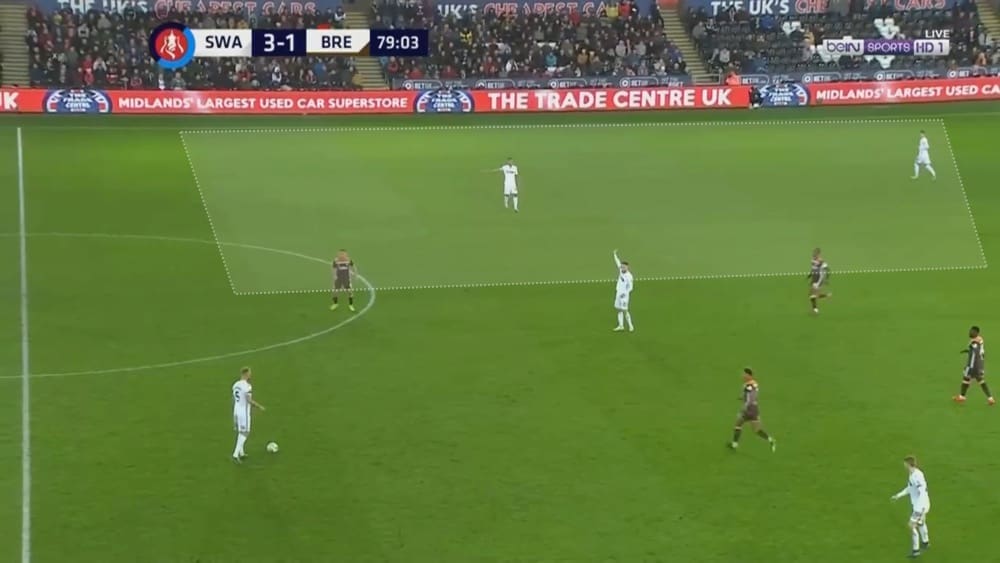
Swansea add more damage
Bersant Celina extended Swansea’s lead to in the 66th minute as he managed to wriggle his way past a couple of Brentford defenders who were guilty of weak tackles. They allowed him through the penalty area before approaching the six-yard box where he could pick out the far corner of the net.
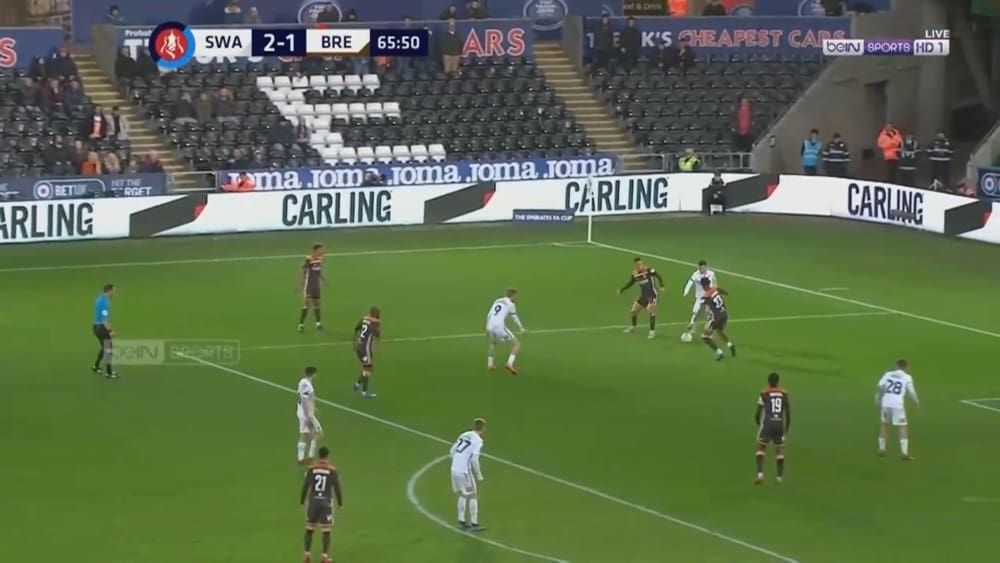
Swansea then thought they had made it 4-1 when Oli McBurnie, from a deep position inside his own half, released Bersant Celina down the left. His shot was parried into Connor Roberts’ path for a simple tap-in but after the celebrations, the play was eventually brought back for an offside call. Judging from where the free-kick was taken, it wasn’t for the first pass (below) but for Roberts who was a yard onside when Celina struck his shot at goal.
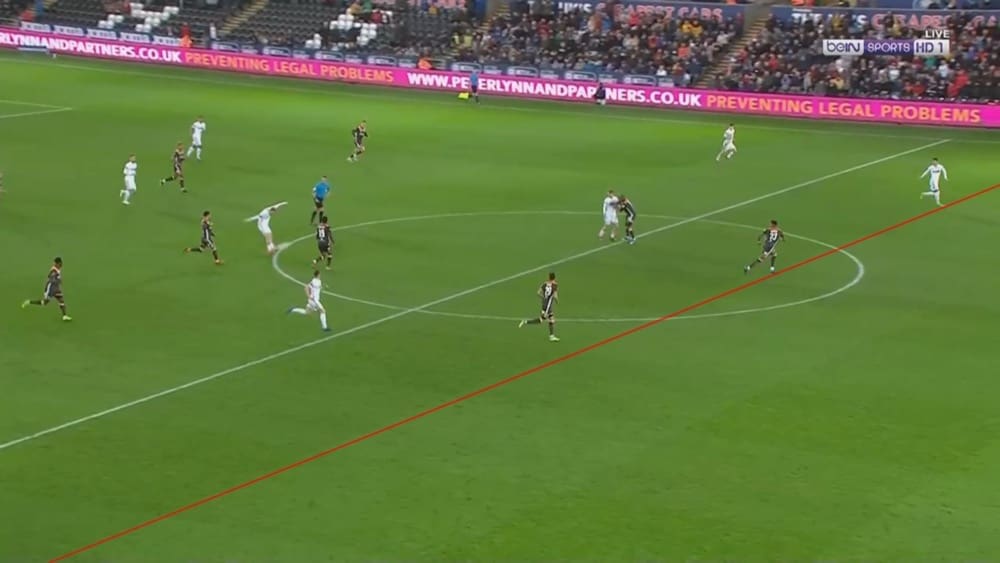
It mattered for very little in the end though as Swansea City did make it 4-1 in the 90th minute as George Byers side-footed a well-placed and well-controlled low shot from outside the box into the bottom left corner. It rounded off what was, in the end, an emphatic FA Cup win for Graham Potter’s men.
Summary
Brentford might see this as a case of what might have been given their first-half performance. They completely nullified Swansea’s passing play from the back, and kept the likes of McBurnie and James very quiet before netting a deserved goal.
Swansea looked out of sorts to say the least, so much so that the home crowd, reduced after calls for a boycott, booed the team off at the break. They never looked capable of getting back into the game, especially so early in the second half.
As previously mentioned, Brentford didn’t make the most of the attacking positions they were able to get themselves into in order to establish a bigger lead at half-time. Of their 10 shots in the first 45, only two found the target.
Dan James proved to be the star of the show for Swansea City. He showed incredible pace for his goal to make it 2-1 and forced the last-man foul and red card, giving his side more freedom to go on and win the game comfortably.
If you love tactical analysis, then you’ll love the digital magazines from totalfootballanalysis.com – a guaranteed 100+ pages of pure tactical analysis covering topics from the Premier League, Serie A, La Liga, Bundesliga and many, many more. Buy your copy of the February issue for just ₤4.99 here, or even better sign up for a ₤50 annual membership (12 monthly issues plus the annual review) right here.

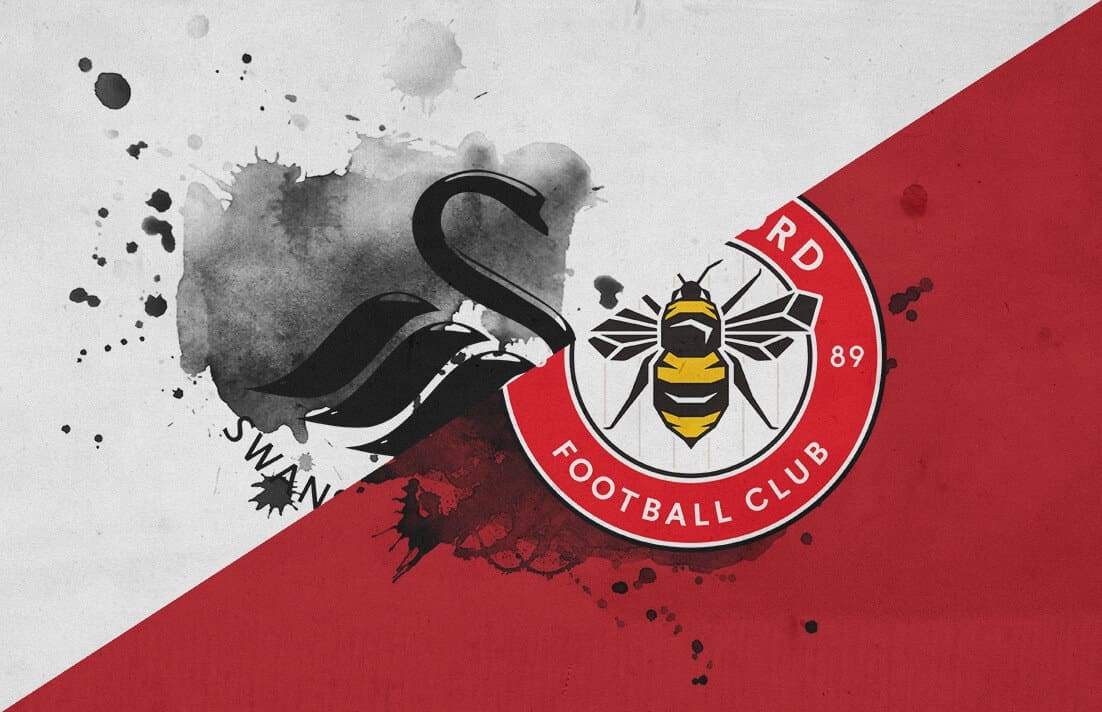




Comments